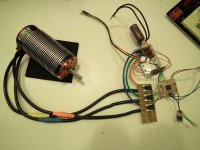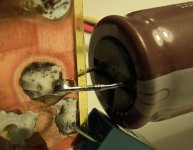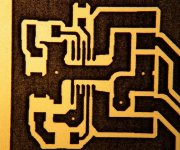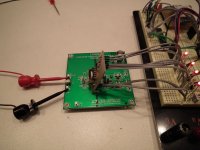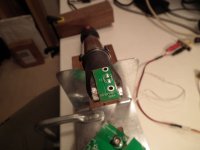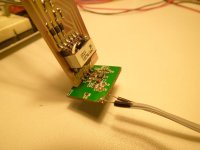Another small update. I have been away from this project for too long so I went back to look at the gate driver supply I'm building.
I'm getting help from a local Field Application Engineer from Linear Technology to use their new
LT3999 - Low Noise, 1A, 1MHz Push-Pull DC/DC Driver with Duty Cycle Control to drive a 1:1:1:1:1:1 push-pull transformer from Würth Electronics. He sent me some samples in DFN package, so I just learned new PCB fabricating and soldering skills, the pads are only 0.25mm wide and spaced 0.25mm and I nailed it in the first attempt, both when etching the PCB and hand soldering the 3x3mm part 8)
The PCB has the LT3999 chip, a few capacitors and resistors to support the LT3999, and the Würth transformer. There are also diodes and capacitors at the output from the transformer.
So basically what I have here is an isolated DC/DC supply with 4 outputs. The idea is to let 3 outputs drive the 3 highside MOSFET drivers, and the last output should drive the 3 lowside MOSFET drivers. The diodes are arranged so that the 3x highside supplies get power from one half of the push-pull switching cycle, and the single lowside supply get power from the other half of the push-pull switching cycle. This way, the power is distributed evenly over the push-pull switching cycles. And since the 3 lowside MOSFET gate drivers share their GND connection through the lowside MOSFET source pins, I can get full gate driver isolation using only 4 isolated supplies e.g. 3x1W for highside and 1x3W for lowside.
Regarding the wattage, I have just done some load tests on the outputs and I see 4.2W on the single lowside output and around 1.3W on the 3 highside outputs, a total of around 8.2W. I should be able to push this to a total of 10W as the datasheet have some typical application circuits with a 10W output so the LT3999 should be capable enough. Maybe I need to use a slightly bigger transformer as the one I use now gets quite warm, so does the LT3999 but that is due to my poor thermal management on the homemade PCB, this will improve with a professional fabricated PCB with power planes and vias.
I will be making a new PCB, preferably after I receive some MSOP package devices that should be easier for me to solder. I will use a bigger Würth transformer on the next board too, to see if that can make a difference on temperature, efficiency and output voltage/current.
I will also receive a demo board from Linear so I have something to compare my own work with.
The Linear Technology push-pull drivers also has the potential of being the driver for an isolated DC/DC supply for my Lebowski chip - with an inductor on the output, the voltage ripple can get as low as 100µV - for a 5V supply, that's 0.002% ripple!


Ok, enough talk, let's see the pictures!


